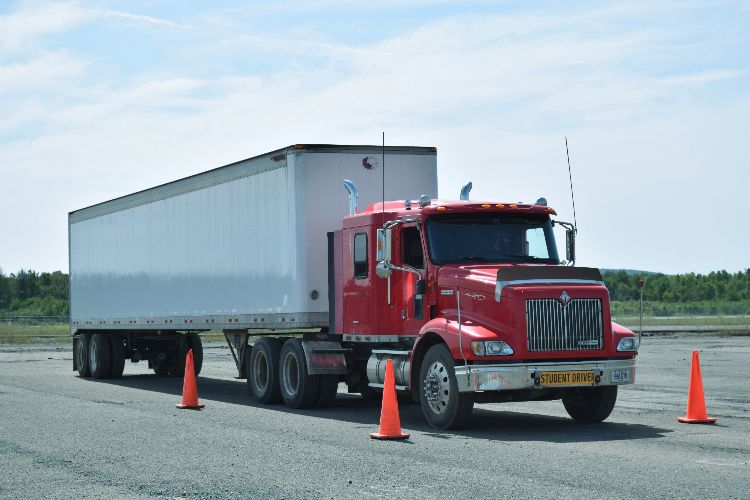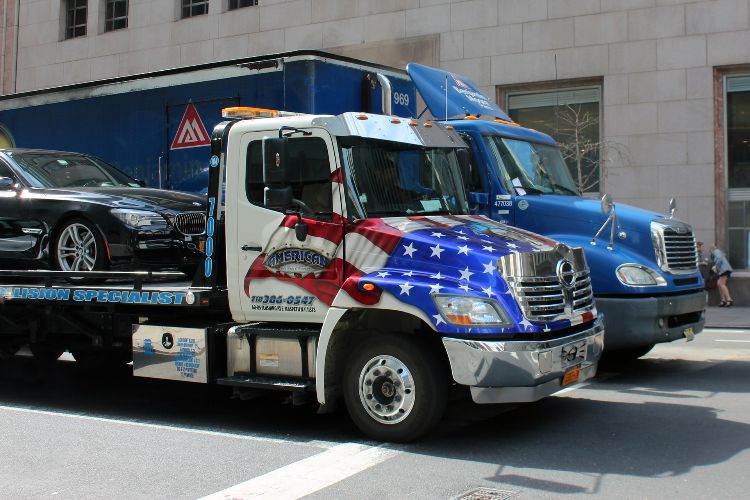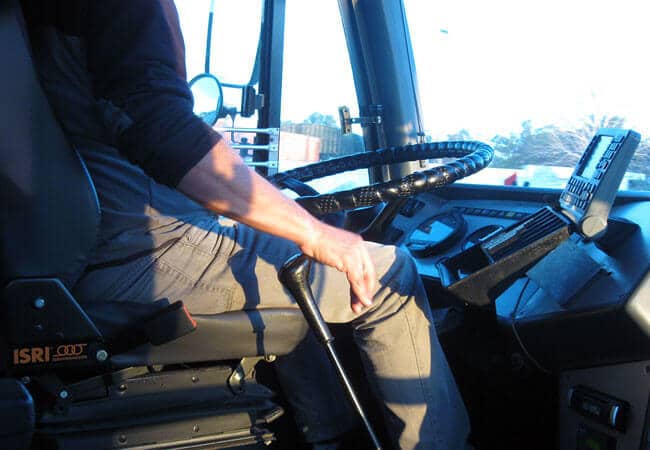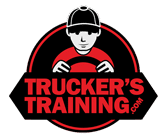The trucking industry is vital to the U.S. economy but has suffered for many years with a shortage of drivers. Changes in standards, pay and conditions have encouraged more recruits to the workforce. To become a truck driver, an applicant must first acquire a Commercial Driver’s License (CDL) and train for this at an approved truck driving school.

Trucking can be a good career choice but the cost of gaining the necessary licensing is an important factor to consider. How much does it cost to get training to become a truck driver?
How Much Does it Cost to Go Truck Driving School?
CDL Tuition
The average fees that schools charge may differ widely between $1000 and $8,000+ as state regulations vary, and schools offer different courses, facilities and certifications. These may lead to a basic CDL qualification or advanced skills and comprehensive classroom/in-truck/on-road training.
Truck driving programs offered at local community colleges or trade schools tend to cost less than those provided by private CDL training companies. For example:
CDL training costs in North Carolina:
Carolina CDL Training Center (private)
- Class A program: $3,500 (automatic); $4,000 (manual)
- Length: 4 weeks, 160 hours
Cape Fear Community College
- Class A program: $1,179
- Length: 8 weeks
Fees are usually commensurate with the type of training and facilities given by the driving school. Importantly, some courses include the costs of the CDL skills and knowledge tests and license fees. If they are not included, applicants must factor in the additional costs.
DMV Fees (Varies by State)
- Commercial Learner’s Permit (CLP) Application Fee
- CDL Application Fee
- Endorsement Fee: varies by state
- Written Test Fee
- Skills / Road Test Fee
- CDL License Fee
CDL license fees vary in each state but range generally from $5-$250 with the skills/knowledge up to $125. There are some options including national training institutes, college courses, and scholarships that claim to keep costs as low as $225. Even so, the applicant and test fees still apply but the need for drivers is high and ongoing so these possibilities are worth pursuing.

Types of CDL
CDLs are offered in 3 categories – A, B, and C – depending on the type of vehicle(s) the applicant is intending to drive. Not all schools offer comprehensive training for all certifications.
| Class A | Driver can operate any combination vehicles with a gross combination weight rating (GVWR) of 26,001 pounds or more whichever is greater, inclusive of a towed unit(s) with a GVWR of more than 4,536 kilograms (10,000 pounds) whichever is greater. | Vehicles:
|
| Class B | Driver can operate any single vehicle with a GVWR of 26,001 pounds or more without a trailer. You can also operate any vehicle towing a trailer that doesn’t exceed 10,000 pounds. | Vehicles:
|
| Class C | Driver can operate any single vehicle or a combination of vehicles not meeting the Class A or Class B definition, that is either designed to transport 16 or more passengers (including the driver), or is transporting hazardous material. | Vehicles:
|
Costs may involve travel to a truck driving school that has a curriculum including training for the relevant license. Accommodation for the course is another consideration if the school is not local.
Types of Trucking Schools

All truckers must have gained their CDL before applying for a post but individual States have some variations in requirements. Schools listed must be licensed and accredited by the local authority and trainers properly qualified. There are 3 standards – Licensed, Certified, and Accredited – offering basic to advanced tuition and accreditation. Most courses last 4-6 weeks.
Low-Cost Truck Driving Schools
Licensed schools that offer basic training and certification may be the least expensive but are not necessarily the best. These may have limited facilities and staff and little help with post-certification job placements. However, the benefits may include a location near the applicant, keeping costs down, or offering part-time courses allowing the trainee to continue regular work while learning.
If funds are limited, an applicant may want to start at a licensed facility that teaches basic training/safety skills for a sole category of CDL. There will be opportunities later to upgrade and acquire advanced or specialist skills.

Medium-Cost Truck Driving Schools
With the national driver shortage continuing to cause concern in the industry, many companies and institutes offer various ways to reduce training costs. Large haulage companies often own training schools and provide low-to-medium-cost training in return for loyalty programs. These involve commitments like working for the company for 1 year or more or refunding a portion of fees through salary deductions. This does mean that trainees will get immediate placements following successful certification for a low initial outlay.
Prime Inc. in Springfield, MO offers comprehensive 3 or 4-week onsite/on-road CDL training courses for around $3,500 in exchange for a year’s company loyalty commitment. The Progressive Truck Driving School in Chicago runs 6-week 240-hour courses (twice that which most schools offer) covering all levels of CDL certification. The cost is somewhat higher at $4800 but the company offers various incentives and benefits to trainees.

High-Cost Truck Driving Schools
These generally have superb facilities, a range of courses and top-notch trainers. Classrooms usually provide high-tech training equipment and trainees can benefit from the flexibility of hours and methods according to individual needs.
For applicants who want to start a career with the best possible qualifications, these schools are ideal but costs may run high up to the top end of around $10,000. Again though, haulage companies may agree to fund a substantial part of the costs which the trainee must return under a reimbursement scheme. These companies may also provide excellent placements with good pay/working conditions. There are also fringe benefits like health care, retirement schemes, and ongoing training for advanced skills.
US Xpress Enterprises, Schneider National, and Werner Enterprises are examples of this kind of arrangement. The disadvantage of these contract training schemes is the loss of freedom. The new trucker will no longer be able to seek out the kind of jobs that suit his/her needs or skills.

Paid CDL Training
Prior to February 7, 2022, you could’ve gotten your CDL without going to a truck driving school. If you had access to a truck to use for the skills / driving test, then your fees would’ve been minimal. Even then, however, we still recommended the importance of going to CDL training.
After February 7, 2022, if you’re looking to get a Class A or B license, or to get endorsements P, S, and H, you’ll need to complete the Entry-level Driver Training (ELDT) through a registered trainer. There is no way around this, because it’s a federally mandated program to increase road safety.
No Upfront Cost CDL Training
Employer Paid CDL Training
There are some trucking companies that offer complete training with no upfront costs. Jim Palmer Trucking, for example, has a package that covers all training plus meals and accommodation for part of the course.
If the applicant is successful in gaining the CDL and stays with the company for a minimum of 12 months, there is truly no upfront cash needed. However, if the trainee fails to stay with the company for the required time, he/she will be liable for the full costs of $3,500.
Free Training Through Trucking School
There are some truck driving schools that offer CDL training for free. Let’s clarify what ‘free’ means. Some CDL schools have long-standing relationships or affiliations with trucking companies, and these companies offer tuition reimbursements. There are some conditions attached to the CDL training reimbursements – for example, the truck driver will need to stay with the company for a specified time. If you want to go this route, just make sure that you understand clearly what is required of you in order for you to get free CDL training.
With the increasing problem of driver shortage, this kind of package is likely to become offered more widely. To date, most of these offers charge trainees moderate fees for a binding contract of work for a specified time.
CDL Grants and Scholarships
If you’re a military veteran or unemployed, there are grants for vets or unemployment grants for CDL training that are available to you if you want to get trained as a truck driver.
Truck Driving School Curriculum

There are different levels of training for the 3 classes of CDL certification and there are also differences between the requirements of each state.Truck Driving Schools provide a range of courses covering basic to advanced skills training and the curriculum affects the costs applicants have to consider.
Courses generally are divided into classroom training and in-truck/on-road (‘hands-on’) applied skills. Each state also requires trainees to pass written and applied skills tests.
Classroom Training
Classroom training covers the basic requirements to become a trucker including wellness, health and safety regulations, and driver qualifications. Other topics include road rules and advanced driving techniques specific to handling large vehicles. Students are also taken through the vehicle components including brakes and hydraulics, air brakes, and auto/manual transmissions.
Another important part of classroom training is learning the pre-trip truck inspection format required by the Department of Transport. Trailer coupling/uncoupling is a skill taught in some courses. Practical knowledge of trip-planning, map reading, using the truck atlas, and setting up the GPS is part of the curriculum in nearly all schools. Understanding the required paperwork at ports and delivery points and keeping accurate logs are other parts of the training before handling the trucks.
Hands-on Training 1
The amount of time spent on the 2 parts of training varies in each school. This stage, however, always involves a lab (practice yard) for practicing how to handle the vehicle. Getting the feel of the gears, backing up, using the brake systems, and all the elements of the truck. Vehicle maintenance and routine inspection are topics also covered at this stage. Some advanced skills can be tried out here which may be particularly important for veteran truckers updating or improving their skills.
Hands-n Training 2
After the lab. stage, trainees go out on the road with an experienced driver/trainer. Here they learn how to drive in various conditions and situations. Rural and urban truck driving will be practiced plus interacting with other regular road users. Use of mirrors, clutch, how to turn, shift, enter and exit highways, and handle the truck at high speeds safely will all be experienced on-road.
Conclusion
Truckers are going to be in demand for many years to come. Researching the average costs is essential for all considering a career in the industry.

Sasha is a freelance writer for TruckersTraining.com and an entrepreneur. She has 10+ years experience as a writer with expertise in the transportation, business and farming industry. She is a wife, a mother, and co-owner of DreCampbell.com.
